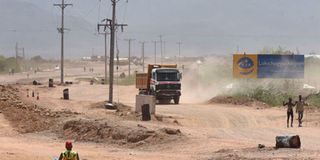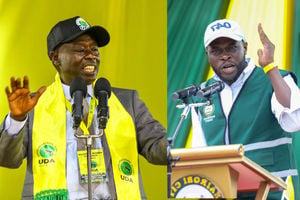Turkana, it’s not all doom and gloom

A section of Lokichoggio Township in Turkana County on December 12, 2021.
What you need to know:
- People are still dying and being horribly withered by hunger.
- Climate change is turning the semi-arid Kenyan regions into a vast patched, dusty, wasteland.
In September, President Uhuru Kenyatta declared a national disaster in 10 counties, mostly in the semi-arid areas, that have been ravaged by drought.
After half a day, national and media attention moved on to presumably more interesting matters like Deputy President William Ruto and former Prime Minister Raila Odinga pre-season dance for the 2022 presidential contest and who is President Kenyatta’s chosen successor, European football, celebrity breakups and make-ups, and, lately, the daylight “robbery” of Lewis Hamilton of the title in the Formula One championship, and Omicron (or Omarion as the young ones call it).
The drought didn’t go away. It continued its march. People are still dying and being horribly withered by hunger. Livestock —and wildlife — have perished in large numbers.
Climate change is turning the semi-arid Kenyan regions into a vast patched, dusty, wasteland. However, in that bleakness, a future might be hiding and, who knows, perhaps not everyone is sad to see drought kill people and ruin their livelihoods.
In the shadows of the 2021 United Nations Climate Change Conference in Glasgow in late October and early November, we got a peek at that future.
An article in The Conversation Africa noted that Morocco has positioned itself as “a global leader in the fight against climate change, with one of the highest-rated national action plans.
Droughts and other calamities
But though the north African country intends to generate half its electricity from renewables by 2030, its plans show that much of this energy will come from wind and solar farms in occupied land in neighbouring Western Sahara (or the Saharawi Arab Democratic Republic as the owners of the territory call it, and its known officially by the African Union).
Morocco has occupied SADR (the last colony on the African mainland) for decades and has had to face Polisario, the region’s liberation movement, for nearly as long. Neighbour Algeria supports Polisario and SADR, and the issue has been a major cause of enmity between Algiers and Tunis.
If you project this picture on a big screen, deserts and semi-arid lands with their deadly sun and winds cease to be useless and become potentially one of the most valuable real estates of the coming renewable energy age.
From that point of view, and taking a cold strategic perspective, some people probably see droughts and other calamities that drive people off semi-arid as something good. By removing them, it drives the cost of the land down and removes the inconvenience of having to buy off or evict residents for future renewable plants.
A while back while on a visit to Pokot, we went to a hill that was being eyed as a future wind farm site. It was an incredible experience. Our car was rocked by wind as we climbed, and I for one couldn’t walk about freely once we stopped and I got out. I had to hold on to the car because it was too gusty. The place was inhospitable, and only a few hardened cattle farmers lived there.
Not too far away, in similar conditions, Kenya built the Lake Turkana Wind Power plant, the largest in Africa. The inhospitable conditions and, to some, impossible winds, are green gold to others. And so it is with deserts and arid lands.
The geopolitical implications of this become clear in Africa’s Sahel region, where extremist violent groups control large areas of desert. If the Sahel is going to be the backbone of the world’s coming solar power order, then the fellows who control it will be kings.
Ragged wind-wealthy hillsides
So, beyond renewable energy sparking new rivalries by countries over what were considered unproductive deserts, it could hand the extremist groups in the Sahel the kind of power other groups that emerged elsewhere in the world to contest oil and mining fields, couldn’t even dream of.
Domestically, though, groups who live in arid regions historically have struggled to have such leverage. The conditions one finds in Turkana, are also found in parts of Uganda’s Karamoja region. Like wind-rich Turkana, it has for decades been plagued by cattle rustling and became highly militarised as cattle herders took up automatic rifles to protect their animals.
For as long as one can remember, it has been in conflict with the central state, and brutal disarmament campaigns are the order of the day.
Uganda has plans to build large solar plants and wind farms in that arid, militarised, and conflict-plagued Karamoja, and West Nile. West Nile is green and parts of it are fertile, but like other areas attracting solar plants and wind farms, was for long marginalised.
These regions, drought-wracked Turkana and Karamoja, the ragged wind-wealthy hillsides, were once backwaters: the places where “development” was alien, which governments didn’t want people talking about, and where hardy nomadic and “resilient indigenous” folks were curiosities to be gawked at by a certain type of tourist, and romanticised by NGOs.
Now they have our attention, even if of the wrong type. Their once seemingly barren soils have what we need. Some of them will do well out of it all, but they should prepare for a lot more tears too.
Mr Onyango-Obbo is a journalist, writer, and curator of the ‘Wall of Great Africans’. Twitter@cobbo3





